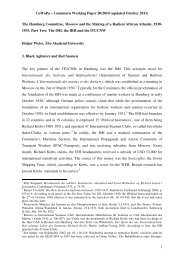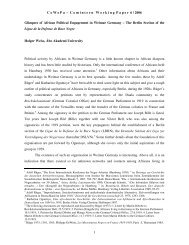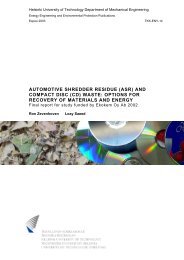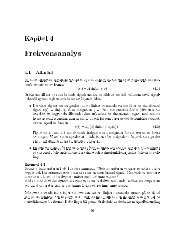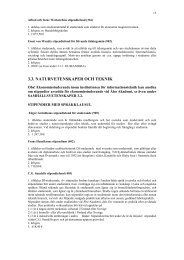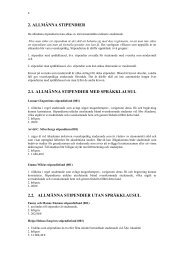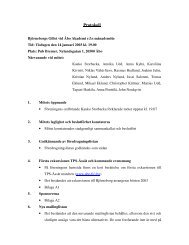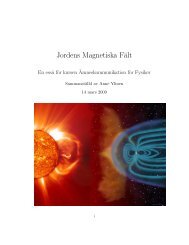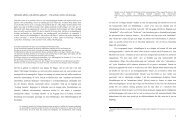biotic couplings on shallow water soft bottoms-examples from the ...
biotic couplings on shallow water soft bottoms-examples from the ...
biotic couplings on shallow water soft bottoms-examples from the ...
Create successful ePaper yourself
Turn your PDF publications into a flip-book with our unique Google optimized e-Paper software.
BIOTIC COUPLINGS ON SHALLOW SOFT BOTTOMS 165<br />
<strong>the</strong> distributi<strong>on</strong> of fish, especially in a situati<strong>on</strong> of interspecific competiti<strong>on</strong> for<br />
food (Westin, 1970; Haahtela, 1975; Hanss<strong>on</strong>, 1980). The benthic system may<br />
also affect <strong>the</strong> success of <strong>the</strong> fish, through altered c<strong>on</strong>diti<strong>on</strong>s <strong>on</strong> <strong>soft</strong>-<strong>bottoms</strong> by<br />
accumulating drifting algae (Janss<strong>on</strong> et al., 1985; Kaaria et al., 1988; Rajasilta<br />
et al., 1989), and <strong>the</strong> benthivorous fish may be affected in both behaviour and<br />
predati<strong>on</strong> efficiency by <strong>the</strong>ir predators (e.g. gobies and cod; Magnhagen &<br />
Forsgren, 1991).<br />
BIRDS AFFECTING THE SHALLOW WATER<br />
ECOSYSTEM<br />
Waterfowl, waders, gulls and birds of prey use <strong>the</strong> archipelago both as a transi-<br />
tory area during <strong>the</strong>ir seas<strong>on</strong>al (spring and fall) migrati<strong>on</strong>s to and <strong>from</strong> <strong>the</strong>ir<br />
nesting grounds, and as actual nesting- and feeding grounds. Generally,<br />
densities are highest am<strong>on</strong>g <strong>the</strong> ducks and gulls, while waders are less comm<strong>on</strong><br />
due to <strong>the</strong> fact that <strong>the</strong> area is n<strong>on</strong>-tidal (Palmgren, 1936). Still, about 60 species<br />
can be recorded, almost half of which may actually breed in <strong>the</strong> area (Palmgren,<br />
1936; Lindholm & B<strong>on</strong>sdorff, 1992; Table IV). Their ecological importance for<br />
<strong>the</strong> <strong>shallow</strong> <strong>water</strong> ecosystem has been estimated for <strong>on</strong>e restricted area in <strong>the</strong><br />
inner archipelago (B<strong>on</strong>sdorff et al., 1990), and it was c<strong>on</strong>cluded that total food<br />
c<strong>on</strong>sumpti<strong>on</strong> by <strong>the</strong> birds (including vegetati<strong>on</strong>) equals about 10% of <strong>the</strong> amount<br />
of food (mainly zoobenthos) c<strong>on</strong>sumed by benthivorous fish. The bird<br />
community changes dramatically with <strong>the</strong> seas<strong>on</strong>s, however, and individual<br />
species redistribute after hatching <strong>the</strong>ir young (Kilpi et al., 1990).<br />
TABLE IV<br />
Some dominant bird species affecting <strong>the</strong> <strong>shallow</strong> <strong>water</strong> ecosystem of <strong>the</strong> archipelagoes<br />
in <strong>the</strong> nor<strong>the</strong>rn Baltic Sea (main feeding habit: bird of prey = Pr,<br />
piscivore = Pi, benthivore = Be, parasitic = Pa, and herbivore = He; and<br />
principal area of occurrence: inner archipelago = I, outer archipelago = 0;<br />
mainly during migrati<strong>on</strong> = *).<br />
Species Feeding type Occurrence<br />
Podiceps cristatus<br />
Cygnus olor<br />
Anus crecca<br />
A. plathyrynchos<br />
A. clypeata<br />
Aythya ferina<br />
A. fuligula<br />
Bucephala clangula<br />
Clangula hyemulis*<br />
Melanitta fusca<br />
M. nigra*<br />
Somateria molissimu<br />
Mergus serrator<br />
M. merganser<br />
Haliaetus albicilla<br />
Pandi<strong>on</strong> haliaetus<br />
Fulica atra<br />
Haemutopus ostralegus<br />
Charadrius hiaticula




